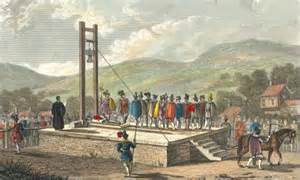The Halifax Gibbet Law

As chronicled by Harry Facks 🎩
"My dear readers,
adjusts monocle with a serious expression
Today we venture into one of Halifax's most notorious chapters - the story of our unique form of justice, the Halifax Gibbet Law. This remarkable legal system set our town apart in medieval England.

Origins of the Law
"The Halifax Gibbet Law emerged from a pressing need:
- Protection of the valuable wool trade
- Deterrent against cloth theft
- Local response to criminal activity
- Self-governance rights granted by the Crown
The Gibbet Mechanism
"Let me describe this fearsome instrument of justice:
- A wooden structure with a mounted blade
- Located on Gibbet Lane
- Operated by a mechanical release
- Preceded the French guillotine by centuries
The Legal Process
"The law followed strict procedures:
- Arrest and Evidence
- Thief caught 'red-handed'
- Stolen goods valued over 13½ pence
- Property had to be clearly identified
- Witnesses required
2. Trial Process
- Held before the local bailiff
- Required 16 jurors
- Public proceedings
- Right of sanctuary at church
Notable Cases
"Between 1541 and 1650:
- Over 50 documented executions
- Last execution in 1650
- Cases recorded in Gibbet Book
- Victims' names preserved
"As your Victorian guide, I must note how this harsh medieval justice system shaped Halifax's reputation and contributed to our town's unique identity. The phrase "From Halifax, from Hell, and Hull, good Lord deliver us" became well-known.
👉 Historical Note: While the Gibbet's methods were harsh, they helped establish Halifax as a trusted trading center, laying the foundation for our industrial success.
Shall we proceed to Chapter 7, where we'll explore the flourishing medieval wool trade that the Gibbet Law protected?"

If you have enjoyed your visit to this website, please spread the word by clicking the 'like' and 'share' buttons below. Thank you


